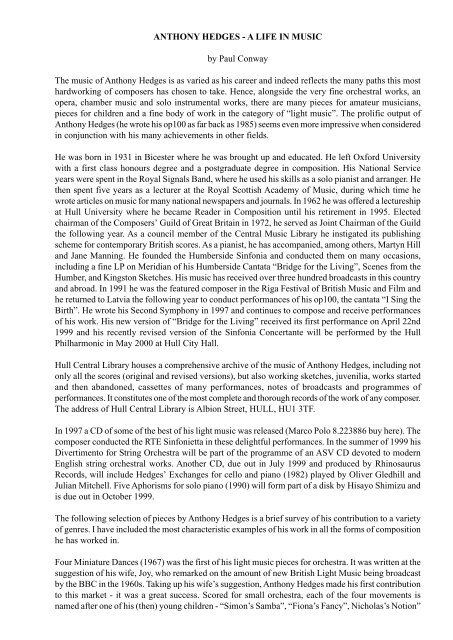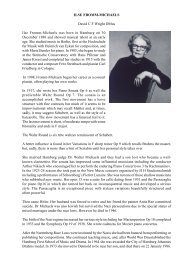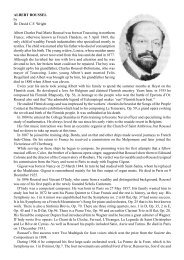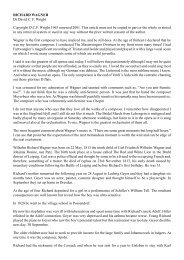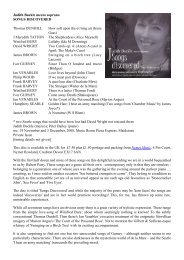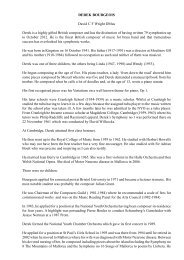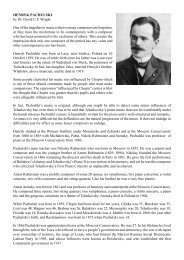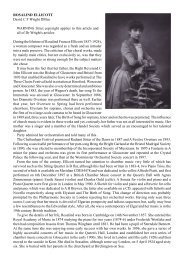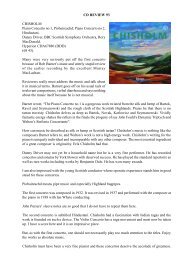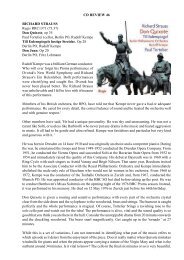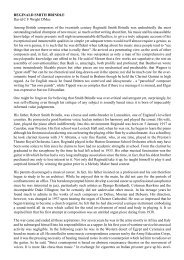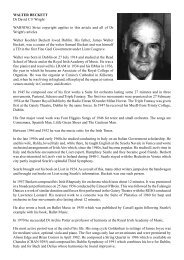Anthony Hedges - A Life in Music (Paul Conway) - Dr David Wright
Anthony Hedges - A Life in Music (Paul Conway) - Dr David Wright
Anthony Hedges - A Life in Music (Paul Conway) - Dr David Wright
- No tags were found...
You also want an ePaper? Increase the reach of your titles
YUMPU automatically turns print PDFs into web optimized ePapers that Google loves.
ANTHONY HEDGES - A LIFE IN MUSICby <strong>Paul</strong> <strong>Conway</strong>The music of <strong>Anthony</strong> <strong>Hedges</strong> is as varied as his career and <strong>in</strong>deed reflects the many paths this mosthardwork<strong>in</strong>g of composers has chosen to take. Hence, alongside the very f<strong>in</strong>e orchestral works, anopera, chamber music and solo <strong>in</strong>strumental works, there are many pieces for amateur musicians,pieces for children and a f<strong>in</strong>e body of work <strong>in</strong> the category of “light music”. The prolific output of<strong>Anthony</strong> <strong>Hedges</strong> (he wrote his op100 as far back as 1985) seems even more impressive when considered<strong>in</strong> conjunction with his many achievements <strong>in</strong> other fields.He was born <strong>in</strong> 1931 <strong>in</strong> Bicester where he was brought up and educated. He left Oxford Universitywith a first class honours degree and a postgraduate degree <strong>in</strong> composition. His National Serviceyears were spent <strong>in</strong> the Royal Signals Band, where he used his skills as a solo pianist and arranger. Hethen spent five years as a lecturer at the Royal Scottish Academy of <strong>Music</strong>, dur<strong>in</strong>g which time hewrote articles on music for many national newspapers and journals. In 1962 he was offered a lectureshipat Hull University where he became Reader <strong>in</strong> Composition until his retirement <strong>in</strong> 1995. Electedchairman of the Composers’ Guild of Great Brita<strong>in</strong> <strong>in</strong> 1972, he served as Jo<strong>in</strong>t Chairman of the Guildthe follow<strong>in</strong>g year. As a council member of the Central <strong>Music</strong> Library he <strong>in</strong>stigated its publish<strong>in</strong>gscheme for contemporary British scores. As a pianist, he has accompanied, among others, Martyn Hilland Jane Mann<strong>in</strong>g. He founded the Humberside S<strong>in</strong>fonia and conducted them on many occasions,<strong>in</strong>clud<strong>in</strong>g a f<strong>in</strong>e LP on Meridian of his Humberside Cantata “Bridge for the Liv<strong>in</strong>g”, Scenes from theHumber, and K<strong>in</strong>gston Sketches. His music has received over three hundred broadcasts <strong>in</strong> this countryand abroad. In 1991 he was the featured composer <strong>in</strong> the Riga Festival of British <strong>Music</strong> and Film andhe returned to Latvia the follow<strong>in</strong>g year to conduct performances of his op100, the cantata “I S<strong>in</strong>g theBirth”. He wrote his Second Symphony <strong>in</strong> 1997 and cont<strong>in</strong>ues to compose and receive performancesof his work. His new version of “Bridge for the Liv<strong>in</strong>g” received its first performance on April 22nd1999 and his recently revised version of the S<strong>in</strong>fonia Concertante will be performed by the HullPhilharmonic <strong>in</strong> May 2000 at Hull City Hall.Hull Central Library houses a comprehensive archive of the music of <strong>Anthony</strong> <strong>Hedges</strong>, <strong>in</strong>clud<strong>in</strong>g notonly all the scores (orig<strong>in</strong>al and revised versions), but also work<strong>in</strong>g sketches, juvenilia, works startedand then abandoned, cassettes of many performances, notes of broadcasts and programmes ofperformances. It constitutes one of the most complete and thorough records of the work of any composer.The address of Hull Central Library is Albion Street, HULL, HU1 3TF.In 1997 a CD of some of the best of his light music was released (Marco Polo 8.223886 buy here). Thecomposer conducted the RTE S<strong>in</strong>fonietta <strong>in</strong> these delightful performances. In the summer of 1999 hisDivertimento for Str<strong>in</strong>g Orchestra will be part of the programme of an ASV CD devoted to modernEnglish str<strong>in</strong>g orchestral works. Another CD, due out <strong>in</strong> July 1999 and produced by Rh<strong>in</strong>osaurusRecords, will <strong>in</strong>clude <strong>Hedges</strong>’ Exchanges for cello and piano (1982) played by Oliver Gledhill andJulian Mitchell. Five Aphorisms for solo piano (1990) will form part of a disk by Hisayo Shimizu andis due out <strong>in</strong> October 1999.The follow<strong>in</strong>g selection of pieces by <strong>Anthony</strong> <strong>Hedges</strong> is a brief survey of his contribution to a varietyof genres. I have <strong>in</strong>cluded the most characteristic examples of his work <strong>in</strong> all the forms of compositionhe has worked <strong>in</strong>.Four M<strong>in</strong>iature Dances (1967) was the first of his light music pieces for orchestra. It was written at thesuggestion of his wife, Joy, who remarked on the amount of new British Light <strong>Music</strong> be<strong>in</strong>g broadcastby the BBC <strong>in</strong> the 1960s. Tak<strong>in</strong>g up his wife’s suggestion, <strong>Anthony</strong> <strong>Hedges</strong> made his first contributionto this market - it was a great success. Scored for small orchestra, each of the four movements isnamed after one of his (then) young children - “Simon’s Samba”, “Fiona’s Fancy”, Nicholas’s Notion”
and “Debbie’s Delight”. These titles (and hence the music) reflect the character of each child at thetime. Four M<strong>in</strong>iature Dances was first performed <strong>in</strong> 1968 by Hull University Orchestra conducted bythe composer. It received its first broadcast on February 27th 1969 by the BBC Concert OrchestraIncluded on the recent Marco Polo CD, the work makes a charm<strong>in</strong>g <strong>in</strong>troduction to the composer’slighter compositions. There are many solos for the woodw<strong>in</strong>d <strong>in</strong>struments and the memorable tunesstay with the listener. This is particularly true of the open<strong>in</strong>g “Simon’s Samba” whose s<strong>in</strong>uous andsuave theme the composer later transcribed for solo woodw<strong>in</strong>d <strong>in</strong>strument and piano.The Holiday Overture of 1968 was first given by the London Studio Orchestra, a performance whichwas broadcast by the BBC on Radio 4. Although the piece received several subsequent broadcasts, thecomposer felt that the work’s four brief m<strong>in</strong>utes’ duration did not do full justice to the material conta<strong>in</strong>edwith<strong>in</strong> it. His <strong>in</strong>st<strong>in</strong>cts were proved right for the result<strong>in</strong>g rework<strong>in</strong>g produced a little masterpiece -the Overture “Heigham Sound” (1978). This ebullient and superbly crafted m<strong>in</strong>iature is every bit theequal of such British overtures as Portsmouth Po<strong>in</strong>t, Derby Day, Beckus the Dandipratt and StreetCorner. A typical <strong>Hedges</strong> theme opens the work and the more relaxed middle section, though clearlyderived from the <strong>in</strong>troductory material, provides the necessary contrast before the ma<strong>in</strong> theme returnsto br<strong>in</strong>g the piece to a suitably upbeat conclusion. Although the overture is named after a beauty spot<strong>in</strong> the Broads <strong>in</strong> East Anglia, the composer hav<strong>in</strong>g spent a holiday there with his family, HeighamSound is not programmatic. Indeed, the pun (<strong>in</strong>tended) <strong>in</strong> the title is as good an <strong>in</strong>dication of thework’s character - witty, high-spirited and unashamedly melodic - as any East Anglian connection.The first performance was given on 20th January 1979 with the BBC Concert Orchestra under AshleyLawrence. Fortunately for us, it was <strong>in</strong>cluded on the Marco Polo CD <strong>in</strong> a bright and affectionateperformance under the composer’s authoritative direction.In 1969, <strong>Anthony</strong> <strong>Hedges</strong> wrote his first unqualified masterpiece <strong>in</strong> the field of orchestral music: theVariations on a Theme of Rameau. The work was first performed by the Northern S<strong>in</strong>fonia under<strong>David</strong> Haslam <strong>in</strong> October 1971, whilst it received its first broadcast <strong>in</strong> December 1973 with the sameorchestra this time under the baton of Sir Neville Marr<strong>in</strong>er. At fifteen m<strong>in</strong>utes’ duration and scored fora small orchestra of 2 flutes, 2 oboes, 2 clar<strong>in</strong>ets, 2 bassoons, 2 horns, trumpet, timpani, percussionand str<strong>in</strong>gs, one’s <strong>in</strong>itial impression of the work as a jolly m<strong>in</strong>iature is deceptive. From the same stableas (and of commensurate quality as) Vaughan Williams’ Tallis Fantasia, Tippett’s Corelli Fantasia,Edmund Rubbra’s Farnaby Improvisations and Ian Parrott’s Dufay Variations, this f<strong>in</strong>e, witty and attimes deeply search<strong>in</strong>g orchestral work makes the most if its apparently simple theme. The theme istaken from the A m<strong>in</strong>or ordre of the second book of Pieces de Clavec<strong>in</strong>, 1731, by Rameau. Over aseries of eleven superbly orchestrated variations, the composer takes elements from the theme (acouple of demisemiqauvers <strong>in</strong> the open<strong>in</strong>g bar, a stepwise progression <strong>in</strong> the flutes <strong>in</strong> the fifth bar andsome unusual cadences) and exploits their potential for development with great skill and imag<strong>in</strong>ation.The structure is more than just a series of variations s<strong>in</strong>ce they form groups which correspond tomovements of a symphony: hence, variations 3 and 4 form a scherzo, Variations 5, 6 and 7 make anextended and search<strong>in</strong>g slow movement, whilst the 9th variation is a second scherzo <strong>in</strong> the form of anextended gigue. Variation 4 conta<strong>in</strong>s remarkable five bars where the upper str<strong>in</strong>gs are divided <strong>in</strong>to 13parts - a brief but tell<strong>in</strong>g effect and <strong>in</strong>dicative of the quality and imag<strong>in</strong>ation of the work as a whole.Variation 5 sounds almost microtonal <strong>in</strong> its whirr<strong>in</strong>g semitonal clashes, whilst Variation 6 is theemotional kernel of the piece, its second half be<strong>in</strong>g particularly powerful. Variation 10 is sparselyorchestrated and meditative <strong>in</strong> feel<strong>in</strong>g, whilst Variation 11 (Allegro energico) is a brilliant fugal F<strong>in</strong>ale.It conta<strong>in</strong>s a rum<strong>in</strong>ative Poco lento section with<strong>in</strong> it which is cut short by the <strong>in</strong>trusion of the return ofthe Allegro energico. The thoughtful nature of these variations even extends to the conclusion which,<strong>in</strong>stead of the usual barnstorm<strong>in</strong>g climax, fades away on a triple piano chord for clar<strong>in</strong>et and upperstr<strong>in</strong>gs. The punchy fourth variation starts off like the scherzo from Prokofiev’s Fifth Symphony andthe F<strong>in</strong>ale has some Shostakovitch-like str<strong>in</strong>g writ<strong>in</strong>g but the work is far from derivative and speaksthe language of <strong>Anthony</strong> <strong>Hedges</strong> at his most impressive. He even occasionally captures someth<strong>in</strong>g ofthe Baroque splendour of the age <strong>in</strong> which the orig<strong>in</strong>al theme was composed. It deserves to be part ofevery orchestra’s repertoire (and not just <strong>in</strong> this country).
In 1969, <strong>Anthony</strong> <strong>Hedges</strong> composed K<strong>in</strong>gston Sketches, one of his most popular pieces, certa<strong>in</strong>ly <strong>in</strong>terms of performances: it received 35 broadcasts between 1971 and 1979 alone. Each of the threemovements reflects the moods suggested to the composer by the street names of Hull. The WhitefriargateWaltz is both wistful and graceful. The reflective central Romance: Silver Street was the last of themovements to be written and the suite closes with the rather impudent and jaunty Ferensway March.As m<strong>in</strong>iature tone poems the three movements manage to capture the essence of the Hull streetswhilst not be<strong>in</strong>g programmatic <strong>in</strong> any literal sense. The piece received the first of its many broadcasts<strong>in</strong> 1971 by the Orchestra of the Light <strong>Music</strong> Society on 28th December 1972.Also <strong>in</strong> 1969, the composer wrote his delightful Ayrshire Serenade. In three movements, the work wascommissioned by the Craigie College of Education <strong>in</strong> Ayr and first performed by the Ayrshire SymphonyOrchestra <strong>in</strong> May 1971. Once aga<strong>in</strong>, it is hard to f<strong>in</strong>d any evidence of programme music here but thecomposer’s personality is stamped on every bar, not least <strong>in</strong> the open<strong>in</strong>g theme of the first movement(Allegro moderato) - an archetypal <strong>Hedges</strong> theme with its heady comb<strong>in</strong>ation of forward momentum,unexpected harmonic twists and brilliant scor<strong>in</strong>g. The follow<strong>in</strong>g Andant<strong>in</strong>o has a beautiful, slightlyrustic theme for oboe which is taken up by the str<strong>in</strong>gs. There is a spirit lift<strong>in</strong>g Tierce de Picardi end<strong>in</strong>g.The good-humoured Vivace F<strong>in</strong>ale conta<strong>in</strong>s some fugal writ<strong>in</strong>g and shares the ebullient mood of theopen<strong>in</strong>g movement. It is good news <strong>in</strong>deed that this attractive work may soon be recorded for a 1999CD release.At this time <strong>in</strong> his career, the composer decided to experiment with serialism. He has said that he has“no love for the Second Viennese School”, but by the end of the 1960s, <strong>Anthony</strong> <strong>Hedges</strong> felt dissatisfiedwith the idiom of his serious works and wanted to explore new avenues of expression. The result<strong>in</strong>gworks (Four Pieces for Piano (1967), Sonata for Viol<strong>in</strong> and Harpsichord (1967), Three Songs of Love(1968) and the Str<strong>in</strong>g Quartet (1970)) are all strictly serial pieces. Of these the Str<strong>in</strong>g Quartet is apowerful, compact one-movement work under twenty m<strong>in</strong>utes <strong>in</strong> length. It was first performed by theLancaster University Str<strong>in</strong>g Quartet, who commissioned it and to whom it is dedicated.The Rhapsody for Viol<strong>in</strong> and Piano of 1971 is an <strong>in</strong>tense and sear<strong>in</strong>g m<strong>in</strong>iature written <strong>in</strong> appreciationof happy times with <strong>David</strong> Roth of the Allegri Str<strong>in</strong>g Quartet. Roth gave the premiere performance ofthe ten-m<strong>in</strong>ute piece with the composer accompany<strong>in</strong>g.Psalm 104 (1973) provides a good example of the high quality of <strong>Anthony</strong> <strong>Hedges</strong>’ choral writ<strong>in</strong>g.Orig<strong>in</strong>ally scored for soprano chorus and brass band, the composer revised the work and produced aversion for choir and orchestra. Last<strong>in</strong>g 18 m<strong>in</strong>utes and divided <strong>in</strong>to four ma<strong>in</strong> sections, the work is apowerful and mov<strong>in</strong>g extended sett<strong>in</strong>g of the Psalm. The open<strong>in</strong>g Allegro vivo beg<strong>in</strong>s with a fanfarelikephrase and the choral writ<strong>in</strong>g is varied, conta<strong>in</strong><strong>in</strong>g canonic as well as <strong>in</strong>cantatory passages. Thefollow<strong>in</strong>g Allegretto grazioso section has an immediately attractive theme which is <strong>in</strong>terrupted by amore animated central passage. The third section (Andante con moto) <strong>in</strong>cludes onomatopoeic writ<strong>in</strong>g(rasp<strong>in</strong>g trombone glissandi at the l<strong>in</strong>e “young lion’s roar”). The open<strong>in</strong>g fanfare returns at the l<strong>in</strong>e“The earth is full of Thy riches”. The brief Moderato F<strong>in</strong>ale has a brass chorale-like open<strong>in</strong>g passageand makes a bright, jazzy conclusion. The fanfare returns for the last time and the end<strong>in</strong>g of the pieceis bold and positive. Psalm 104 was first performed by the massed forces of East Rid<strong>in</strong>g SchoolChoirs and York Brass Band at Beverley M<strong>in</strong>ster <strong>in</strong> April 1974. Two years later the work was performed<strong>in</strong> the Royal Albert Hall.Although <strong>Anthony</strong> <strong>Hedges</strong> had written a symphony as a student <strong>in</strong> 1954, he later withdrew the piece.His opus 1a is a S<strong>in</strong>fonietta (1955) which was also later withdrawn. In 1963 he wrote a S<strong>in</strong>foniaSemplice which was given its first complete performance by Bryden Thomson with the GlasgowSchools First Orchestra <strong>in</strong> July 1963. In 1975, he completed his Symphony no 1. Build<strong>in</strong>g on thesymphonic strengths already present <strong>in</strong> such works as the Rameau Variations and us<strong>in</strong>g the skills <strong>in</strong>orchestration so evident is his lighter works, the Symphony is an outstand<strong>in</strong>g achievement. Firstperformed on 27th February 1978 by the BBC Northern Orchestra under that great champion of
<strong>Hedges</strong>’ work, Bryden Thomson, a concert performance of the Symphony took place not long after atthe Royal Northern College of <strong>Music</strong>. The piece is a taught and powerful work <strong>in</strong> three movements,which lasts just over twenty m<strong>in</strong>utes. The composer began the Symphony <strong>in</strong> 1973 and worked at it <strong>in</strong>between the many commissions he had at his time.The first movement (Allegro Scorrevole) was <strong>in</strong>spired by an extra-musical idea: namely, the desire topromote new ideas com<strong>in</strong>g up aga<strong>in</strong>st the entrenched views of the status quo. The str<strong>in</strong>gs and later thewoodw<strong>in</strong>d represent the push<strong>in</strong>g forward aspect of <strong>Hedges</strong>’ idea whilst the status quo is representedby static brass chords which halt the rush<strong>in</strong>g str<strong>in</strong>gs and woodw<strong>in</strong>d. The work beg<strong>in</strong>s with a stealthystr<strong>in</strong>g theme which forms the basis of the movement and much of the rest of the symphony’s argument.The brass enters at fig 2 with menac<strong>in</strong>g chords. The str<strong>in</strong>gs cont<strong>in</strong>ue at fig 4 with an <strong>in</strong>tricate fugalpassage. At the height of the str<strong>in</strong>gs’ argument the brass chords return (fig 10). At fig 13, woodw<strong>in</strong>dand percussion enter for the first time, the woodw<strong>in</strong>d sp<strong>in</strong>n<strong>in</strong>g arabesques. The clar<strong>in</strong>ets play a ris<strong>in</strong>gfigure at fig 14 which will reappear <strong>in</strong> the Trio of the follow<strong>in</strong>g movement. At fig 16, the str<strong>in</strong>g themereappears on first viol<strong>in</strong>s, jo<strong>in</strong><strong>in</strong>g the woodw<strong>in</strong>d flourishes. After fig 23, the brass chords jo<strong>in</strong> <strong>in</strong>. Thefirst movement ends abruptly, its arguments unresolved with the two elements of movement and stasislocked <strong>in</strong> opposition.Release of a k<strong>in</strong>d comes with the unh<strong>in</strong>dered momentum of the brief but <strong>in</strong>tensely rhythmical Scherzosecond movement marked Allegro Ritmico. This movement starts with timpani and percussion only,mak<strong>in</strong>g great use of the percussion section. A four-note motif on the xylophone assumes significance,especially after it is expanded <strong>in</strong>to a five-note motif <strong>in</strong> a speeded up version on the vibraphone. Atfigure 5 the viol<strong>in</strong>s play a distorted version of the ma<strong>in</strong> theme of the previous movement. The Trio ischaracterised by a chromatic figure for woodw<strong>in</strong>ds over harp chords. It is a development of the floridwoodw<strong>in</strong>d material from the open<strong>in</strong>g movement. The Scherzo is reprised and after a climax at fig 21,the movement fades away, its mechanical whirr<strong>in</strong>g spent.The F<strong>in</strong>ale is a search<strong>in</strong>g Andante which reflects on the earlier material. The open<strong>in</strong>g phrase is adistorted version of the ma<strong>in</strong> motif. The movement builds <strong>in</strong> <strong>in</strong>tensity up to a triple forte climax. Aftera tutti pause (fig 5), the horns play another version of the ma<strong>in</strong> theme. The lower str<strong>in</strong>gs at a bar beforefig 6 play a pizzicato version of the ma<strong>in</strong> theme of the Scherzo. The follow<strong>in</strong>g brass chords are nowsubdued, literally muted. Fragments of the Symphony’s ma<strong>in</strong> theme flit about the orchestra, pass<strong>in</strong>gfrom oboes to flutes to horns and violas, to trumpets, to viol<strong>in</strong>s, end<strong>in</strong>g up on clar<strong>in</strong>ets. The hornchords sound for the last time - still quiet, but this time without mutes. The work ends on a questionmark, a str<strong>in</strong>g chord dy<strong>in</strong>g away to noth<strong>in</strong>g. The Symphony is a work of its time: it has failed to f<strong>in</strong>dan optimistic conclusion, achiev<strong>in</strong>g repose without resolution.“Bridge for the Liv<strong>in</strong>g” was written for the official open<strong>in</strong>g of the Humber Bridge. It is a cantatasett<strong>in</strong>g for tenor soloist, chorus and orchestra of the poem by Philip Lark<strong>in</strong> “A Liv<strong>in</strong>g Bridge”. It wascommissioned by the Hull firm J H Fenner and Co Ltd <strong>in</strong> 1975 and written that year <strong>in</strong> the confidentexpectation that the Humber Bridge would be completed shortly. In fact, when the work received itsbelated premiere on April 11th 1981 by the Hull Choral Union, the official open<strong>in</strong>g of the Bridge wasstill some three months away. This was an important commission, not just because it marked theopen<strong>in</strong>g of the Bridge but it was the only time Philip Lark<strong>in</strong> had written a poem specifically for amusical sett<strong>in</strong>g. Indeed, “Bridge for the Liv<strong>in</strong>g” is the first ever extended sett<strong>in</strong>g for chorus andorchestra of any of Lark<strong>in</strong>’s poems. The text is quite different from Lark<strong>in</strong>’s usual style with itsatmospheric imagery which almost cries out for musical treatment. As the moods change dramaticallybetween most of the ten four-l<strong>in</strong>e stanzas, the composer wrote brief orchestral <strong>in</strong>terludes as transitionsbetween them. The sett<strong>in</strong>g opens with a slow orchestral prelude establish<strong>in</strong>g the mood of the poemand this prelude, together with the motif with which the chorus enters provides the basis for the entirework’s material. The first verse is spare, sung by a semi-chorus, tak<strong>in</strong>g its general character from thewords “Isolate City”. An orchestral l<strong>in</strong>k changes the mood ready for the entry of the full chorus <strong>in</strong>verse two, which homes <strong>in</strong> on the words “work<strong>in</strong>g skyl<strong>in</strong>e” to provide a battery of busy percussion,
particularly <strong>in</strong> the lustrous new orchestration. Verses three and four are given to the tenor soloist, thechorus tak<strong>in</strong>g over <strong>in</strong> the second part of verse four. The quiet open<strong>in</strong>g of verse five gives way to belllikesounds expressed chorally <strong>in</strong> a brief seven-part cannon, after which another orchestral l<strong>in</strong>k changesthe mood for verse six. The dramatic change of mood <strong>in</strong> the poem at this po<strong>in</strong>t is reflected <strong>in</strong> the musicby a change <strong>in</strong> tempo and dynamics, together with an <strong>in</strong>crease <strong>in</strong> dissonance. The choir treats versesseven and eight as one unit. Verse n<strong>in</strong>e starts as a meditation for soloist and male voices, but the fullchoir re-enters halfway through. At this po<strong>in</strong>t the music beg<strong>in</strong>s its ascent (<strong>in</strong> the form of a steadycrescendo) to a f<strong>in</strong>al climax, the unashamedly tonal conclusion mirror<strong>in</strong>g the optimism of the poem’sconclusion. The score is both excit<strong>in</strong>g and sensitive to the poetry it constantly enhances. Theperformance on the 1981 Meridian LP with the Hull Choral Union and the Humberside S<strong>in</strong>fonia doesthe orig<strong>in</strong>al score full justice. The Hull Choral Union performance of the revised version on April22nd 1999 was even more impressive, show<strong>in</strong>g that the composer has lost none of his orchestrat<strong>in</strong>gskill. The imag<strong>in</strong>ative percussion writ<strong>in</strong>g <strong>in</strong> particular has added even more sparkle to this alreadydazzl<strong>in</strong>g score.The Festival Dances of 1976 is arguably the composer’s masterpiece <strong>in</strong> the field of Light <strong>Music</strong> andone of his most enjoyable and masterly scores <strong>in</strong> any category. It was commissioned by the Boroughof Milton Keynes for the Jubilee and was first performed by the Royal Liverpool Philharmonic Orchestraunder Sir Charles Groves on June 7th 1977. It received its first broadcast by the BBC NorthernSymphony Orchestra under Bryden Thomson who was a strong advocate of the music of <strong>Anthony</strong><strong>Hedges</strong>. The first dance, Allegro vivace, conta<strong>in</strong>s one of its composer’s most irresistible melodies.After a brilliant fanfare, the first subject is a bright and vivacious tune, all harmonic twists and turns.The second subject, first heard on woodw<strong>in</strong>d, is an offshoot of the first - it is remarkable how often,like Haydn before him, <strong>Anthony</strong> <strong>Hedges</strong> uses the same material from his ma<strong>in</strong> themes for his secondsubjects - both composers be<strong>in</strong>g men <strong>in</strong> a hurry whose <strong>in</strong>vention skips along at a bewilder<strong>in</strong>g rate. Thecentral dance, Lento ma non troppo conta<strong>in</strong>s a middle section with a modal chorale for brass andstr<strong>in</strong>gs which is rem<strong>in</strong>iscent of the second movement of Respighi’s P<strong>in</strong>es of Rome - both themes aremonumental and rise to a hypnotic climax before dy<strong>in</strong>g down aga<strong>in</strong> like a spent force of Nature. Theconclud<strong>in</strong>g Allegro assai is upbeat and brightly scored, the irrepressible ma<strong>in</strong> theme from the open<strong>in</strong>gmovement return<strong>in</strong>g to round off a gem of a piece which deserves to be heard <strong>in</strong> the concert halls andreleased on CD. Its cont<strong>in</strong>u<strong>in</strong>g absence from either medium does British Light <strong>Music</strong> a great disservice.Also <strong>in</strong> 1976, <strong>Anthony</strong> <strong>Hedges</strong> wrote his one and only opera (so far). “Shadows <strong>in</strong> the Sun” is a twoactopera for soloists, children’s chorus and orchestra of two hours’ duration. It was first performed byKelv<strong>in</strong>hall School, with the Humberside S<strong>in</strong>fonia conducted by the composer <strong>in</strong> June 1977. Thecomposer, together with his librettist, a locally based TV writer called Jim Hawk<strong>in</strong>s, developed theidea of writ<strong>in</strong>g an opera which would <strong>in</strong>volve professional soloists and orchestra, but whose plotwould demand a chorus of young children. Hence, the result<strong>in</strong>g work is not a children’s opera butrather an opera which <strong>in</strong>cludes a children’s chorus, thus giv<strong>in</strong>g young people a chance to experiencereal opera from the <strong>in</strong>side. Three different choirs from the Hull region were used <strong>in</strong> the three firstperformances so as to <strong>in</strong>volve the maximum amount of children <strong>in</strong> the area. Sadly such schemes arerare. They demonstrate <strong>Anthony</strong> <strong>Hedges</strong>’ passionate commitment to music education and his profoundbelief <strong>in</strong> the importance of a composer’s place <strong>in</strong> the community.Prayers from the Ark (1976) is an excellent example of <strong>Anthony</strong> <strong>Hedges</strong>’ sensitive writ<strong>in</strong>g for voiceand piano. In this case, the piece is a sett<strong>in</strong>g of n<strong>in</strong>e poems of Carmen Bernos de Gasztold <strong>in</strong> the formof a song cycle for tenor (or soprano) and piano. The n<strong>in</strong>e poems are the prayers of the differentanimals <strong>in</strong> the Arc, their <strong>in</strong>dividual characters expressed <strong>in</strong> musical terms sound<strong>in</strong>g occasionally human.The piece has a tell<strong>in</strong>g wit and makes a delightful addition to the repertoire. Martyn Hill, who gave thefirst performance of the work with the composer accompany<strong>in</strong>g on the piano, commissioned thework.The Piano Trio of 1977 demonstrates the strength of the composer’s writ<strong>in</strong>g for chamber music forces.
It is dedicated to the Leonardo Trio (Maureen Smith - viol<strong>in</strong>, Anna Shuttleworth - cello, Ian Brown -piano), who gave the first performance <strong>in</strong> 2nd November 1978. The pound<strong>in</strong>g chorale-like open<strong>in</strong>gsets the scene and provides some of the subsequent material of the work, the Allegro section tak<strong>in</strong>gthe repeated-note thematic fragment from the Andante con moto <strong>in</strong>troduction. The central Lento sectionconta<strong>in</strong>s dramatic harmonies and is notable for its ecstatic, Messiaen-like piano chords. After thewhirlw<strong>in</strong>d of the penultimate pages, the clos<strong>in</strong>g passage is the slowed-down version of the ma<strong>in</strong>repeated-note motif with which the work began. On many occasions <strong>in</strong> the piece <strong>Anthony</strong> <strong>Hedges</strong>contrasts the lyrical nature of the str<strong>in</strong>g <strong>in</strong>struments with the percussive quality of the piano. Anotherof the composer’s compact and closely argued one movement works, the Piano Trio manages to packa great deal of matter <strong>in</strong>to its fourteen m<strong>in</strong>utes. The Leonardo Trio gave a Radio3 broadcast of thepiece whilst the Tunnel Trio has broadcast it twice.The Temple of Solomon (1979) is another important work for Chorus and Orchestra. It is a sett<strong>in</strong>g ofthe story of Solomon’s Temple taken from Biblical sources compiled by the composer himself. Divided<strong>in</strong>to four sections (Prologue, The Build<strong>in</strong>g of the Temple, The Dedication and Celebrations), the pieceis a brilliantly scored piece which tests the musicianship of the chorus to the full, whether <strong>in</strong> thework’s many powerful climaxes or <strong>in</strong> the joyous laudatory Celebrations. The orchestra is not withoutits own virtousic passages, <strong>in</strong>clud<strong>in</strong>g represent<strong>in</strong>g the saw<strong>in</strong>g and stone-lay<strong>in</strong>g of the Build<strong>in</strong>g of theTemple or depict<strong>in</strong>g swarm<strong>in</strong>g locusts <strong>in</strong> the solo tenor section “If there be dearth…” The work isdedicated to the Huddersfield Choral Society and they gave the first performance of the work atHuddersfield Town Hall on April 2nd 1982. When the work was first reviewed, some critics unfairlycompared it with Walton’s Belshazzar’s Feast, a lazy comparison display<strong>in</strong>g a lack of understand<strong>in</strong>gof the <strong>Hedges</strong> style which is at all times true to itself and never a pale imitation of other <strong>in</strong>fluences - itis too strong <strong>in</strong> character for that. Taken on its own terms, surely the best form of appraisal of anywork of Art, The Temple of Solomon is a powerful and <strong>in</strong>ventive piece which will appeal to anyonewho can respond to melody and well-crafted orchestration.The suite Four Breton Sketches was written <strong>in</strong> 1980 and first performed and broadcast by the BBCConcert Orchestra under Ashley Lawrence 0n 7th July of that year. It was written after a holiday thecomposer spent with his family <strong>in</strong> Brittany. Each of the four movements expresses a mood suggestedto the composer by a location or event on that holiday. Thus, <strong>Anthony</strong> <strong>Hedges</strong> is careful not to claimany programmatic content <strong>in</strong> the work. However there is one place where the composer is clearlydepict<strong>in</strong>g an actual event: <strong>in</strong> the third movement, a m<strong>in</strong>i rondo entitled “Promenade: a D<strong>in</strong>ard”, soundsof car hooters <strong>in</strong>trude <strong>in</strong>to a relaxed saunter along the promenade. Four Breton Sketches is an enchant<strong>in</strong>gwork and makes a great curta<strong>in</strong> raiser on the Marco Polo CD.Scenes from the Humber (1980) was commissioned by the BBC for a concert to celebrate the officialopen<strong>in</strong>g of the Humber Bridge on 17th July 1981. It was first performed on that occasion <strong>in</strong> Hull CityHall by the BBC Northern Symphony Orchestra under Gunter Herbig, the first of many performances.The work rivals K<strong>in</strong>gston Sketches as the most frequently played of <strong>Anthony</strong> <strong>Hedges</strong>’ orchestralworks. A companion piece to the K<strong>in</strong>gston Sketches, Scenes from the Humber is another evocativepiece of light music which captures the very spirit of Hull and its environs. It was recorded as part ofthe Meridian LP and later re-recorded on the Marco Polo CD. In four movements are entitled PetuariaPatrol, Spurn Po<strong>in</strong>t Elegy, The L<strong>in</strong>coln Castle and Humber Keel Hornpipe. Petuaria was the Romanname for Brough, ten miles west of Hull. This open<strong>in</strong>g march-like movement beg<strong>in</strong>s quietly andgradually <strong>in</strong>creases <strong>in</strong> <strong>in</strong>tensity before reced<strong>in</strong>g aga<strong>in</strong> <strong>in</strong>to the distance - a musical device known as a“patrol” - once aga<strong>in</strong> <strong>Anthony</strong> <strong>Hedges</strong> delights <strong>in</strong> puns <strong>in</strong> his titles. The movement describes theRoman cohorts who used to cross the north bank of the Humber approach<strong>in</strong>g and pass<strong>in</strong>g by and is ahighly evocative piece of writ<strong>in</strong>g. Spurn Po<strong>in</strong>t is a deserted promontory of land at the mouth of theHumber which provides a sanctuary for seabirds. Cries of these birds can be heard <strong>in</strong> the <strong>in</strong>troductionand <strong>in</strong> the wake of the stormy climax of this sparsely orchestrated and evocative movement. “TheL<strong>in</strong>coln Castle” was the last of the paddle steamers to serve as a Humber ferry. Its design and atmospheresuggested the 1920s even though it was built two decades later. Hence the jazzy style of the movement.
The chugg<strong>in</strong>g rhythms of the ferry are also captured. Humber Keels were flat-bottomed sail<strong>in</strong>g bargesthat plied their trade up and down the Humber <strong>in</strong> the late 19th and early 20th centuries. Their annualregatta formed an important event <strong>in</strong> the life of the river and an oil pa<strong>in</strong>t<strong>in</strong>g of the first of theseregattas, show<strong>in</strong>g the Humber Keels provided the start<strong>in</strong>g po<strong>in</strong>t for this f<strong>in</strong>al movement with its typicallyebullient and high-spirited ma<strong>in</strong> theme, entirely characteristic of its composer.The Jackdaw of Rheims (1980) is another hugely enjoyable choral piece composed for amateur forcesbut never obviously “written down”. Requir<strong>in</strong>g soprano choir, speaker and orchestra, the work wascommissioned by the Solihull Education Department and first performed by the Solihull Youth Orchestrawith massed junior choirs from local schools. A brass fanfare announces the start of the work and astirr<strong>in</strong>g march accompanies the chorus. A memorable theme accompanies the words for the chorus: “Inand Out” as the jackdaw flies around. There is a timpani-led scherzo-like episode as the jackdaw makesoff with the Card<strong>in</strong>al’s r<strong>in</strong>g. As the jackdaw is rendered lame, there is a fractured version of the open<strong>in</strong>gmarch - a good example of how <strong>Hedges</strong> always gives the best of himself to every work, whether dest<strong>in</strong>edfor professional or amateur forces. The upbeat end<strong>in</strong>g is suitably joyful with tambour<strong>in</strong>e and tubularbells add<strong>in</strong>g to the colourful score. At about fifteen m<strong>in</strong>utes, the piece is great fun, both to perform andto listen to, doesn’t outstay its welcome and f<strong>in</strong>ds the composer at his sunniest and most genial.The S<strong>in</strong>fonia Concertante was commissioned by the Hull Philharmonic Orchestra for its centenary <strong>in</strong>1982. The orchestra gave the first performance of the work on February 22nd 1982 and will give thepremiere of the revised version of the work <strong>in</strong> the spr<strong>in</strong>g of the year 2000 <strong>in</strong> Hull City Hall. Compactand sparkl<strong>in</strong>g, the work is suitably celebratory <strong>in</strong> style. The Hull Philharmonic performance will beone to savour if their outstand<strong>in</strong>gly committed recent performances of symphonies by Arnold, Josephsand Joubert are anyth<strong>in</strong>g to go by.Exchanges is a ten-m<strong>in</strong>ute piece for cello and piano. Composed <strong>in</strong> 1982, its tempo mark<strong>in</strong>g “Pocolento e flessibile” characterises the work. Moray Welsh and <strong>Anthony</strong> Goldstone commissioned“Exchanges” and gave the premiere of the orig<strong>in</strong>al version of the work at the Royal Exchange Theatre,Manchester on the 5th December 1982. The composer revised the piece the follow<strong>in</strong>g year. Thisrevised version, played by cellist Oliver Gledhill and pianist Julian Milford is soon to be released ona Rh<strong>in</strong>osaurus Records CD.Also <strong>in</strong> 1982, the composer wrote his Flute Sonat<strong>in</strong>a. A ten-m<strong>in</strong>ute work <strong>in</strong> three short movements forflute and piano, it shows <strong>Anthony</strong> <strong>Hedges</strong> at his sunniest and best. The first movement (Moderato) isShostakovich-like <strong>in</strong> its triplet-ridden ma<strong>in</strong> theme. The jazzy second theme is closely related to thefirst and has the composer’s f<strong>in</strong>gerpr<strong>in</strong>ts all over it. Semitonal clashes <strong>in</strong> the piano part add spice tothe texture. The Poulenc-like purity of the Andant<strong>in</strong>o second movement is deceptive s<strong>in</strong>ce the movementrises to an impassioned climax before fall<strong>in</strong>g back to the Gallic charm of the open<strong>in</strong>g melody. Thefleet-footed, virtuosic F<strong>in</strong>ale (Allegro scherzando) has a scamper<strong>in</strong>g, wide-rang<strong>in</strong>g open<strong>in</strong>g themeand a witty second subject entirely characteristic of <strong>Anthony</strong> <strong>Hedges</strong>. The throwaway end<strong>in</strong>g is aperfect f<strong>in</strong>ish<strong>in</strong>g gesture and rounds off one of the most enjoyable pieces of chamber music I have yetheard. The first performance of the Flute Sonat<strong>in</strong>a took place on 14th May 1982 with Ian Denley asflautist and the composer accompany<strong>in</strong>g. In 1984 <strong>Anthony</strong> <strong>Hedges</strong> made an orchestral version (FluteConcert<strong>in</strong>o for flute and chamber orchestra) which demonstrates the basically large-scale nature of allhis works, no matter how small-scale the forces may be.Pieces of Eight (1982) was a work commissioned by eight dist<strong>in</strong>guished pianists. It is scored for eightpianists and four pianos. A year after the first performance, the composer re-scored the slow movementunder the title of “Cantilena”. This beautifully orchestrated and understated four-m<strong>in</strong>ute piece is thankfully<strong>in</strong>cluded on the Marco Polo CD. It is an exquisite microcosm of all the virtues of <strong>Anthony</strong> <strong>Hedges</strong> as acomposer of light music and the haunt<strong>in</strong>g theme stays <strong>in</strong> the m<strong>in</strong>d long after the music has f<strong>in</strong>ished.The Viola Sonat<strong>in</strong>a (1982) is another well-crafted chamber piece of about ten m<strong>in</strong>utes’ duration.
Tougher <strong>in</strong> its language than the Flute Sonat<strong>in</strong>a, for example, it has moments of great solemn beautynonetheless. The first movement (Moderato con moto) is at time almost orchestral <strong>in</strong> its grand sonorities.The brief scherzo-like Molto Vivace second movement is like a moto perpetuo with a memorablyattractive Trio section, whilst the F<strong>in</strong>ale is a beautiful slow movement (Poco lento e molto flessibile).It was first performed by Keith Lovell and Brian Newbould at Hull University <strong>in</strong> November 1984.Six Moods (1984) are six short pieces for piano. They are written for different standards of player, thefirst two be<strong>in</strong>g with<strong>in</strong> the Grade 4 range, the second two be<strong>in</strong>g suitable for Grade 5 whilst the f<strong>in</strong>altwo are more exact<strong>in</strong>g. The pieces have explanatory titles: Contentment, Assertion, Whims, Energy,Reflection and Aggression and expertly convey the moods suggested by their titles. The work lastsn<strong>in</strong>e m<strong>in</strong>utes.The Cleveland Overture was composed <strong>in</strong> 1984, hav<strong>in</strong>g been commissioned by the Cleveland YouthOrchestra, who gave the first performance under <strong>Anthony</strong> <strong>Hedges</strong> <strong>in</strong> March 1985. A month later,the work received its first broadcast with the BBC Concert Orchestra under Ashley Lawrence. Thema<strong>in</strong> theme is another excellent example of the composer’s seem<strong>in</strong>gly <strong>in</strong>exhaustible supply offirst-rate tunes. Once aga<strong>in</strong>, the oboe-led secondary theme is closely related to the open<strong>in</strong>g melody.This brilliantly orchestrated six-m<strong>in</strong>ute work makes a perfect curta<strong>in</strong> raiser and would grace thestart of any concert programme.The Fantasy Sonata for bassoon and piano (1986) is another well-written piece of chamber musicwhich deserves to be heard. Unusually, this short twelve-m<strong>in</strong>ute work is cast <strong>in</strong> five movements -lento-allegro, moderato-allegro molto, lento, allegro vivace and lento. Once aga<strong>in</strong> the writ<strong>in</strong>g for solo<strong>in</strong>strument is entirely idiomatic, emphasis<strong>in</strong>g the enormous range of the bassoon from growl<strong>in</strong>g bassto its highest register. The piece enhances this repertoire, exploit<strong>in</strong>g the lyrical as well as the comicpotential of its solo <strong>in</strong>strument and provides a test of the musicianship as well as the technique of thesoloist. It was commissioned by Hull University <strong>Music</strong> Department and first performed by RichardMoore, the dedicatee, accompanied by the composer on 17th June 1987.Refractions (1987) is a piece for clar<strong>in</strong>et and str<strong>in</strong>g quartet, a f<strong>in</strong>e example of <strong>Anthony</strong> <strong>Hedges</strong>’ latestyle <strong>in</strong> the field of chamber music. The fragments of melody and harmony set out <strong>in</strong> the slow<strong>in</strong>troduction are comb<strong>in</strong>ed and recomb<strong>in</strong>ed throughout the rest of the work, reveal<strong>in</strong>g their differentfacets, shades of colour and chang<strong>in</strong>g moods. It is dedicated to James Campbell and the Allegri Str<strong>in</strong>gQuartet and first performed by them on 15th June 1988. A compact work <strong>in</strong> a s<strong>in</strong>gle span of just under15 m<strong>in</strong>utes, the work is cast <strong>in</strong> three sections (Lento- moderato con moto-andante-allegro vivo). Thevariants on the <strong>in</strong>itial material <strong>in</strong>clude a fugal variation and canonic writ<strong>in</strong>g. A variant near the end ofthe piece, characterised by spiccato triplets <strong>in</strong> the lower str<strong>in</strong>gs, sounds like the negative image of thesecond subject of the Heigham Sound Overture. The piece is <strong>in</strong> the composer’s most serious ve<strong>in</strong>, yetit rema<strong>in</strong>s a darkly attractive and approachable work.Five Aphorisms for piano (1990) shows the composer at this toughest and least compromis<strong>in</strong>g. Thesebrief, epigrammatic pieces have their lighter moments and display a mastery of the <strong>in</strong>strument. Thecentral Allegro vivace is a McCabe-like moto perpetuo which is loud, brief and angry but which slowsdown and fades <strong>in</strong>to silence. The follow<strong>in</strong>g Lento conta<strong>in</strong>s some Messiaen-like chordal writ<strong>in</strong>g. FiveAphorisms was recently recorded by Hisayo Shimizu as part of a forthcom<strong>in</strong>g CD released byRh<strong>in</strong>osaurus Records. The movements are: Vivace, con moto, Fluente, Allegro vivace, Lento andAllegro.I’ll Make me a World (1990) was commissioned by Coventry Centre for the Perform<strong>in</strong>g Arts and firstperformed by Coventry Youth Orchestra and massed local choirs <strong>in</strong> May 1991. Of the same highquality as “The Jackdaw of Rheims”, the piece is one-movement twenty-m<strong>in</strong>ute work for chorus andorchestra. It beg<strong>in</strong>s mysteriously with hushed str<strong>in</strong>gs <strong>in</strong> their upper register and an exotic repeatedphrase on xylophone. The bass soloist jo<strong>in</strong>s with the words “And God stepped out <strong>in</strong> Space”. The
chorus enters with a recurr<strong>in</strong>g descend<strong>in</strong>g two-note phrase on the words “I’m lonely”. A lively andpunchy theme accompanies the words “And God said ‘That’s good!’ “. There is a march-like sectionwhere God walks upon the earth. The punchy theme is also used at the “Amen” clos<strong>in</strong>g section.Skilfully written and well-judged <strong>in</strong> relation to what young voices can manage, this piece speaks withthe unmistakable voice of its composer and is one of his most enjoyable works <strong>in</strong> any medium.“In Such a Night” was written for str<strong>in</strong>g quartet <strong>in</strong> 1990 and received its first performance by theAllegri Str<strong>in</strong>g Quartet at Hull University <strong>in</strong> November 1990. The piece is a rhapsodic, atmosphericnocturne with frequent solos for viol<strong>in</strong> and cello. The modal-sound<strong>in</strong>g writ<strong>in</strong>g and the soar<strong>in</strong>g viol<strong>in</strong>solo make the ma<strong>in</strong> theme a second cous<strong>in</strong> to Vaughan Williams’ “The Lark Ascend<strong>in</strong>g”. The recurr<strong>in</strong>gmotif takes the four syllables of the title and turns them <strong>in</strong>to a yearn<strong>in</strong>g arch-like figure. The beautiful,rich sonorities drawn from the quartet would seem ready-made for expand<strong>in</strong>g to a larger str<strong>in</strong>g ensembleand the composer subsequently created a str<strong>in</strong>g orchestra version which was given its first performanceby the Hull University Orchestra at St Mary’s Church, Beverley <strong>in</strong> February 1992.Showpiece (1994) is as East Rid<strong>in</strong>g Youth Orchestra commission and jo<strong>in</strong>s the ranks of the HeighamSound and Cleveland Overtures as brilliantly orchestrated concert openers. The composer derived theopen<strong>in</strong>g theme from ERYO. It is <strong>in</strong> loose sonata form, but <strong>in</strong> place of the normal development section,the composer wrote a m<strong>in</strong>i Young Person’s Guide to the Orchestra, giv<strong>in</strong>g each <strong>in</strong>strument a solo spot,start<strong>in</strong>g with the piccolo and the rest of the woodw<strong>in</strong>d over a str<strong>in</strong>g tremolo. The str<strong>in</strong>gs are <strong>in</strong>troducedfrom the double basses upwards and there is a splendid fugue for the str<strong>in</strong>g section as a whole. Thema<strong>in</strong> theme of the piece is v<strong>in</strong>tage <strong>Hedges</strong>, jazzy but qu<strong>in</strong>tessentially English, all harmonic twists andturns, swiftly chang<strong>in</strong>g keys with the sleight of hand of a true Master. It all works perfectly and isgreat fun to play and to listen to.The Symphony no 2, opus 130, composed <strong>in</strong> 1997 awaits its first performance. I hope this event willnot be long forthcom<strong>in</strong>g s<strong>in</strong>ce it appears to be a work every bit as well-crafted as its predecessor. Itbears a superscription from Wilfrid Owen:“With news of all the nations <strong>in</strong> your hand“And all their sorrows <strong>in</strong> your face”.The Owen quote came to the composer’s m<strong>in</strong>d <strong>in</strong> the early stages of compos<strong>in</strong>g the symphony, aris<strong>in</strong>gfrom the music he was writ<strong>in</strong>g. It cont<strong>in</strong>ued to haunt him and is perhaps an <strong>in</strong>dication of the characterof the piece. It is scored for piccolo, 2 flutes, 2 oboes, B flat clar<strong>in</strong>et, 2 bassoons, 4 horns, 3 trumpets,2 trombones, bass trombone, tuba, timpani, percussion (2 players), harp and str<strong>in</strong>gs. A one-movementwork of much substance, it deserves a champion to br<strong>in</strong>g it before the public.The Divertimento for Str<strong>in</strong>g Orchestra (1998) is a revised and rescored version of Four Diversions forstr<strong>in</strong>g orchestra composed <strong>in</strong> 1971. The second subject of the charm<strong>in</strong>g open<strong>in</strong>g Allegro commodosounds very similar to the open<strong>in</strong>g theme of the second movement of Sibelius’s Fifth Symphony. Thistheme recurs throughout the work. The Presto F<strong>in</strong>ale boasts a typical <strong>Hedges</strong> theme, second cous<strong>in</strong> tothe first Festival Dance. A fugal passage <strong>in</strong>itiates the recapitulation and the work ends adroitly andwithout fuss. It is due to be released on an ASV CD <strong>in</strong> summer 1999 as part of a disc celebrat<strong>in</strong>gmodern English works, conducted by <strong>David</strong> Lloyd Jones. The composer was impressed with theplayers (taken from the Birm<strong>in</strong>gham Royal Ballet orchestra) and this certa<strong>in</strong>ly is a release to look outfor.With performances and record<strong>in</strong>gs <strong>in</strong> prospect and both new compositions and re-orchestrations ofprevious works produced <strong>in</strong> the last decade, <strong>Anthony</strong> <strong>Hedges</strong> is still very active <strong>in</strong> the world of British<strong>Music</strong>. He now publishes most of his own works, which may be bought or hired direct from him. Thecomposer has a website (http://www.westfieldmusic.karoo.net/) and an e-mail address:(ahedges@westfieldmusic.karoo.co.uk). Though there are many neglected British composers to be
found throughout the 20th Century, the most recent examples are perhaps the most unforgivable. Itmay be that <strong>Anthony</strong> <strong>Hedges</strong>’ decision to stay <strong>in</strong> the North of England has cost him some of theadulation and exposure afforded those composers who ply their trade <strong>in</strong> the Capital. Nonetheless, thequality of his music will live on: it sh<strong>in</strong>es through <strong>in</strong> a whole series of impressive scores. Though it issplendid to have the Marco Polo CD and the prospect of more light pieces and a raft of chamber workson CD <strong>in</strong> the near future, the absence <strong>in</strong> the catalogue of pieces such as the Symphonies, the RameauVariations and any of the choral works and concertos is a sore omission which any right-th<strong>in</strong>k<strong>in</strong>grecord company would do well to put right. The cont<strong>in</strong>u<strong>in</strong>g unavailability of the p<strong>in</strong>nacles of <strong>Anthony</strong><strong>Hedges</strong>’ work on CD is a major disappo<strong>in</strong>tment and one can only hope that future generations, luckierthan our own, will one day have an opportunity to re-discover his greatest compositions and thus reevaluatehis achievement as a composer.©<strong>Paul</strong> <strong>Conway</strong> 4/99 renewed 2012. This article or any part of it, however small, must not becopied, quoted, reproduced, downloaded or altered <strong>in</strong> any way whatsoever nor stored <strong>in</strong> any retrievalsystem. Failure to comply is <strong>in</strong> breach of International Copyright Law and will render any offenderliable to action at law.


